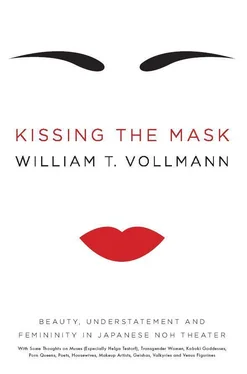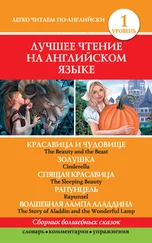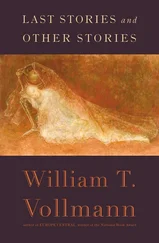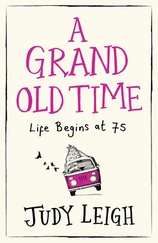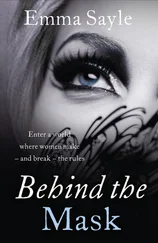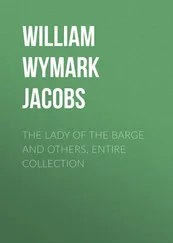6This jealous woman-snake is customarily represented by either a ja or hannya mask. She may also incarnate herself in the omi-onna mask, as in the first act of “Dojoji.”
7As for male masks, in the interest of gender equality I condescend to give them a footnote. Boys’ masks are the doji and the kashiki , “a young male role that has both secular and religious aspects.” Chujo and imawaka are for young noblemen and warriors. Chujo means “deputy,” and is fairly frequently seen — for instance in “Michimori.” Heita represents a warrior of middle age. An old man is shown by the akobujo , a category which may or may not include the san-ko-jo , which once again appeared in Mr. Mikata’s production of “Michimori.” The ayakashi, yase otoko and kawazu represent angry male ghosts. There are also masks specific to, and named for, the roles of Kagekiyo, Semimaru, Shojo, Shunkan, Yorimasa, Yoroboshi. (When I asked how many of his fifty masks would be available to choose from for “Kagekiyo,” Mr. Mikata accordingly replied: “Basically two, one with a beard, and one without. But that was not a good question.”) The Okina mask has already been introduced. Hakushikijo and kokushikijo are for gods, tobide and beshimi for demons.
1The very sequence of plays performed on a given day ought to conform to this scheme. Thus the plays may be considered acts of an ephemeral meta-play. This conception dates at least back to the Heian period, when tankas of Japanese court poetry were sometimes organized into great narratives whose elements had been composed by many poets in diverse centuries.
2Renoir: “For a battle piece to be good, it must look like a flower piece.”
3A brilliant case in point is the character of Princess Rokujo in “Aoi-no-Ue.” Envy of Prince Genji’s other lovers, and in particular of his first wife, has transformed her into a hideous demon represented by a hannya mask. One observer speaks of the play’s demand that the shite “temper the compelling sharpness of aggression with the elegance befitting Princess Rokujo… jealousy was transformed into an experience of beauty.”
4However, when many pictures on the same paper stock, processed identically, are viewed together, the image color loses relevance. This is so even in the case of cyanotypes, whose blue seems peculiar or even (a favorite adjective in the literature) “objectionable” when seen alongside their platinum or silver gelatin cousins; a portfolio of a hundred cyanotypes, however, restores the composition itself to primacy.
5To accomplish it, the performer is more essential than the text; for Noh can sometimes succeed through a half-definable quality called heart . When this occurs, an actor is so outstanding that even a banal play will move the audience.
1Played by Kongo Hisanori, circa 2005.
2Since this book has to do particularly with feminine beauty, my textual analysis of Noh need not attempt profundity to such an extent as would embarrass my mediocrity. All the same, just as to know the beauty of a woman is not only and sometimes not ever to know her nude, but yet to know her pretty clothes and charming artifices, her ways of speaking and of thought, the virtues of her heart, her tastes and whims, and not least her relatives, so when kissing the Noh mask it is all the more delicious to have a sense of its allusions and antecedents.
3He stars briefly in another classic, The Taiheiki , which ascribes to his virtue the power to see his enemy, a twelve-headed sky giant borne by eight dragons. And so the mansion of Noh has opened unto us one more textual room.
4Meanwhile, Fenollosa writes: “In the fifteenth century after Christ, the Japanese drama arose out of religious rites practised in the festivals of the Shinto gods, chiefly the Shinto god of the Kasuga temple at Nara.”
5In the previous chapter, I quoted another translator’s phrase, “flower of tranquility,” in order to remind myself of the folly of grasping for exact equivalents.
6One English-language compilation presumes that the bowl must be oxidized, since then its hue would bear “the mysterious beauty of stillness.”
7Who gets her own chapter below, p. 166.
8One commentator opines that “the nostalgia for the life of the Court” of the Heian period, when Genji was written, “was the real keynote of the renaissance in the Muromachi period. But because this past splendor could no longer be recaptured in the world of reality, the memory was transmuted into a longing for things eternal and imperishable, with profound metaphysical results in the world of ideas.”
9Most Noh plays contain such a honzetsu or “seed.” For instance, the sad love story “Izutsu” is based on three chapters from The Tales of Ise .
10Thus my barbarian’s approach to the concept of hon’i , the decorum appropriate to the expression of a given subject — very relevant to Noh, obviously, or to a geisha’s multi-step procedure for opening a sliding door. On the subject of cherry blossoms, poets had to “express impatience in waiting for their blooming, delight in their beauty, and distress in their falling.” This goes far to explain why it is in Mr. Umewaka’s words “very controversial” if a theater paints a young instead of an old pine tree on the mirror-board.
1Noh was influenced by Tendai Buddhism, some of which can be traced back to Ch’an in China. Among the treasures of Ch’an teachings we find The Blue Cliff Record , whose preface is dated 1128. I quote that book’s Thirteenth Case in full: “A monk asked Pa Ling, ‘What is the school of Kanadevi?’ Pa Ling said: ‘Piling up snow in a silver bowl.’ ” The pointer to the case reads in part: “When snow covers the white flowers, it’s hard to distinguish the outlines. Its coldness is as cold as snow and ice; its fineness is as fine as rice powder. Its depths are hard for even a Buddha’s eye to peer into…”
1The Heian aesthetic both derives and diverges from Chinese sources. Among the latter we find the eighth-century joy girl Chao Luan-Luan writing encomia of scarlet-nailed fingers as narrow as new-peeled onions; of teeth like white melon seeds and lips like pomegranate blossoms; of willow-leaf eyebrows, of cool, creamy soft breasts whose nipples resemble “the pegs of a jade inlaid harp.” “Her poems were a common type,” remarks the translator, “a sort of advertising copy in praise of the parts of a woman’s body, written for courtesans and prostitutes.” Hence she ought to be an authority on feminine beauty; her clients put their money where her mouth was. Among the items on her list, only the willow-leaf eyebrows insist on being noticed in the Japanese Manyoshu ’s court poetry. The white teeth of Chinese pulchritude certainly do not find their match in the Manyoshu . If I can visualize more attributes of the Chinese than the Japanese ideal, perhaps both Chinese and Japanese would have wanted it that way.
2For just this reason, in the pornographic shunga woodcuts of the period, the color of a woman’s teeth provides a cue as to whether or not her depicted liaison is adulterous.
3The scrolls employ the so-called hikime kagibana technique of drawing faces. First and foremost, features are rendered obliquely rather than frontally. The outline of a female face is urizane-gata (winter melon shaped), plumpening from eyes to cheeks. The forehead is lofty, the long hair parted in front and layered on the shoulder. A few strands pass across the edge of an eye. Eyebrows are drawn straight and long in many lines, with the ends shaded off. Eyebrows and eyes are considerably separated and straight and slanted. “The nose is drawn only as a little ‘ ku ’ (resembles a “<���”), with no more detail than that. The mouth is a small red dot with a slight black ink line. This is accordingly called the (small mouth). The chin is also small. If the face is drawn from the side, we see only an eye brow and an edge of the eye.” We are informed that the hikime kagibana face is calm, emotionless. “It seems to be understood that showing big emotions are ugly. Elegance and silence comprise the beauty of the Tale of Genji .”
Читать дальше
